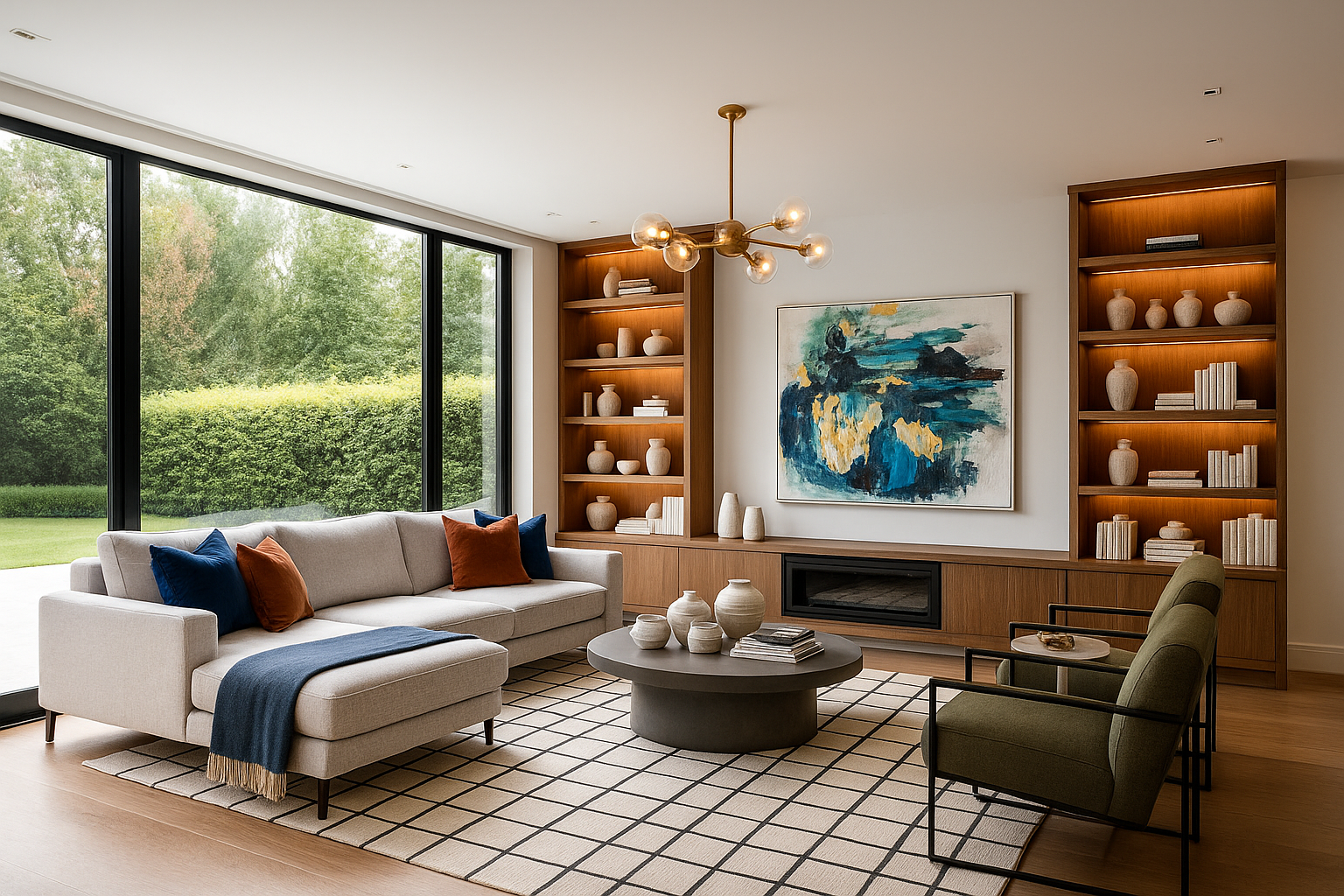Walking into a beautifully furnished home feels different from entering an empty space. The furniture you choose doesn’t just fill rooms – it creates the entire personality of your living space. Every chair, table, and cabinet tells a story about who you are and how you live.
Most people think furniture is just about having somewhere to sit or store things. But the truth goes much deeper. The right furniture choices can make a small apartment feel spacious and welcoming, while poor choices can make even a mansion feel cramped and uncomfortable.
I learned this lesson the hard way when I moved into my first apartment. I bought whatever was cheapest and fastest to get, thinking I’d upgrade later. That “later” stretched into three uncomfortable years of a wobbly dining table, a couch that hurt my back, and storage that never quite worked for my daily routine.
Your furniture shapes every moment you spend at home. It affects your mood when you wake up, your productivity when you work, and your comfort when you relax. The decisions you make about furniture today will influence your daily experience for years to come.
The Foundation of Interior Design: Why Furniture Matters More Than You Think
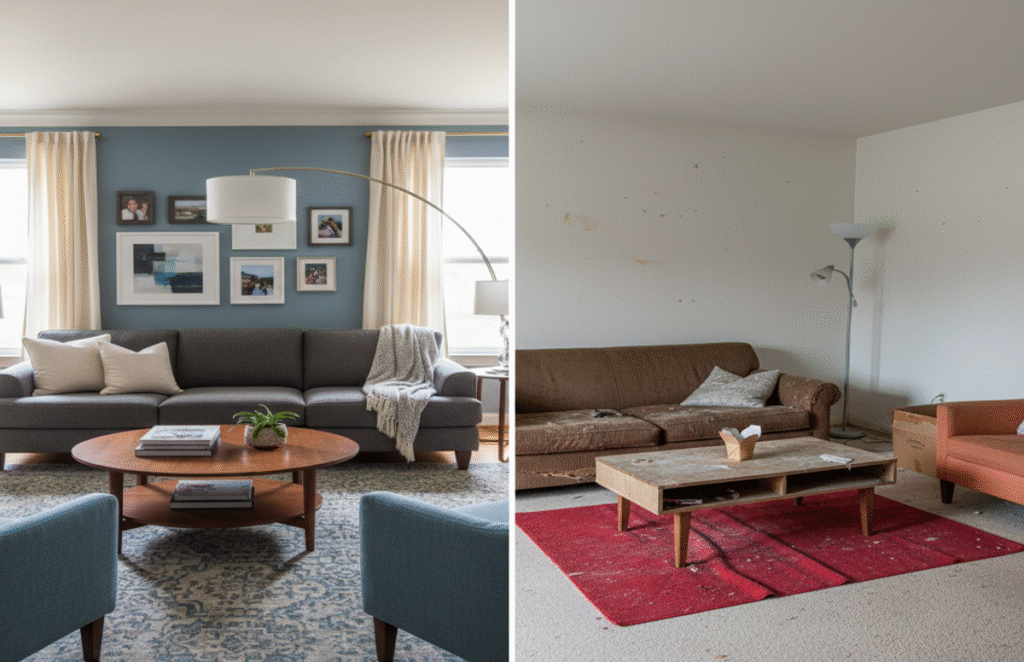
Setting the Visual Tone and Atmosphere
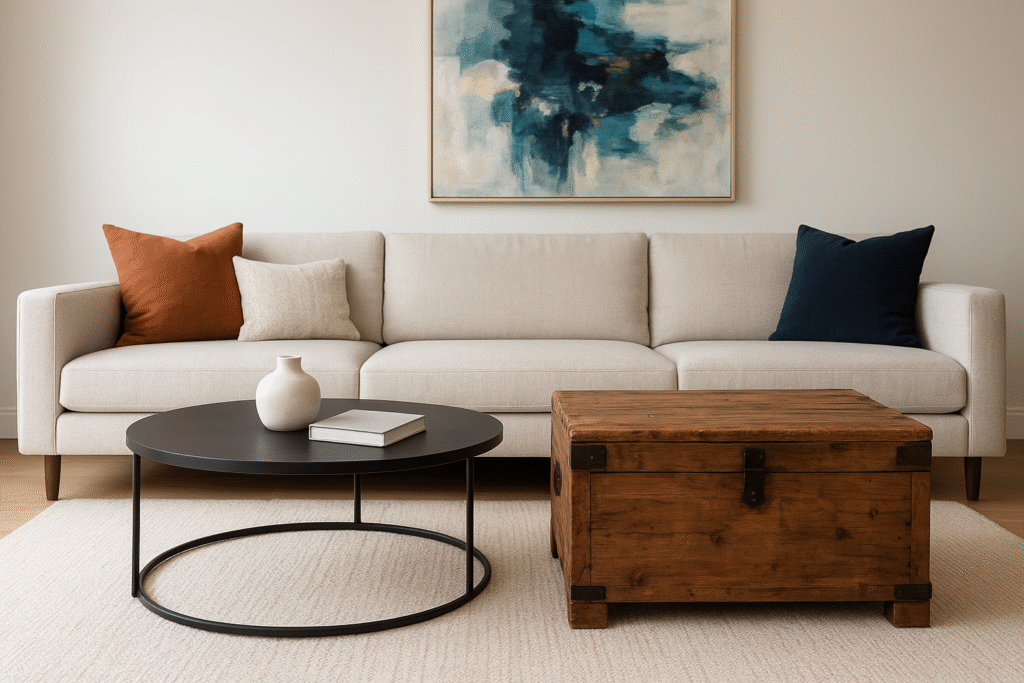
Furniture serves as the visual foundation of every room in your home. When you walk into a space, your eyes naturally gravitate toward the largest pieces first – the sofa, dining table, or bed. These pieces immediately communicate what kind of atmosphere you can expect.
A sleek, minimalist coffee table creates a completely different feeling than a rustic wooden trunk serving the same purpose. The first suggests clean lines and modern living, while the second hints at cozy evenings and relaxed gatherings. Neither choice is right or wrong, but each sets a distinct emotional tone.
The furniture you choose also acts as visual anchors that help organize a room. Without these anchor points, even the most expensive paint colors and decorations can feel scattered and purposeless. I’ve noticed this when visiting homes where beautiful art and accessories seem to float without connection – usually because the furniture doesn’t provide enough visual weight to ground the space.
Creating consistency between rooms doesn’t mean everything must match exactly. Instead, think about how your living room furniture relates to what’s visible in the dining area or kitchen. Repeating certain wood tones, similar leg styles, or complementary colors helps your home feel intentional rather than randomly assembled.
Functional Requirements That Drive Daily Living
Beyond appearance, furniture must support the way you actually live. Your daily routines depend on having the right pieces in the right places. Consider how often you use your dining table – is it mainly for quick breakfast, family dinners, or working from home? Each use requires different considerations for size, height, and durability.
Traffic flow through your home depends heavily on furniture placement. The path from your front door to the kitchen, or from the bedroom to the bathroom, should feel natural and unobstructed. I’ve seen beautifully decorated rooms that felt uncomfortable because you had to navigate around furniture rather than through thoughtfully planned spaces.
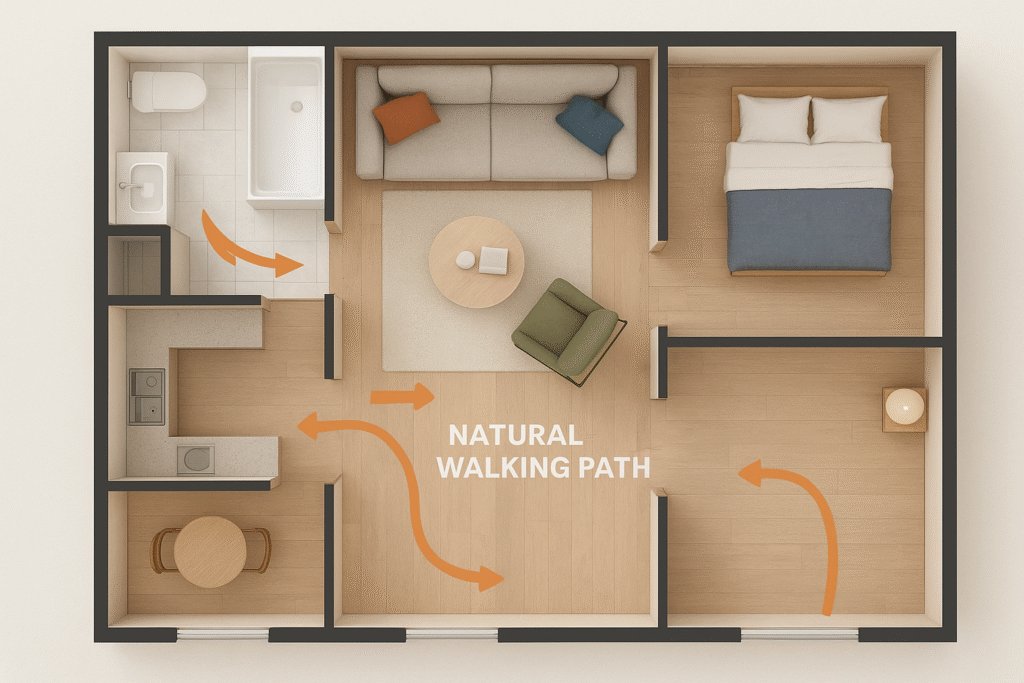
Different household members bring different needs to furniture selection. Children require sturdy construction and easy-to-clean surfaces, while elderly family members might need lower seating or furniture with arms for easier standing. Pet owners need to consider scratch-resistant materials and washable fabrics.
The key is thinking beyond just filling empty space. Ask yourself what activities happen in each room and what furniture would best support those activities. A reading chair needs good lighting and a side table for books and coffee. A home office needs storage for supplies and comfortable seating for long work sessions.
Long-term Investment and Value Considerations
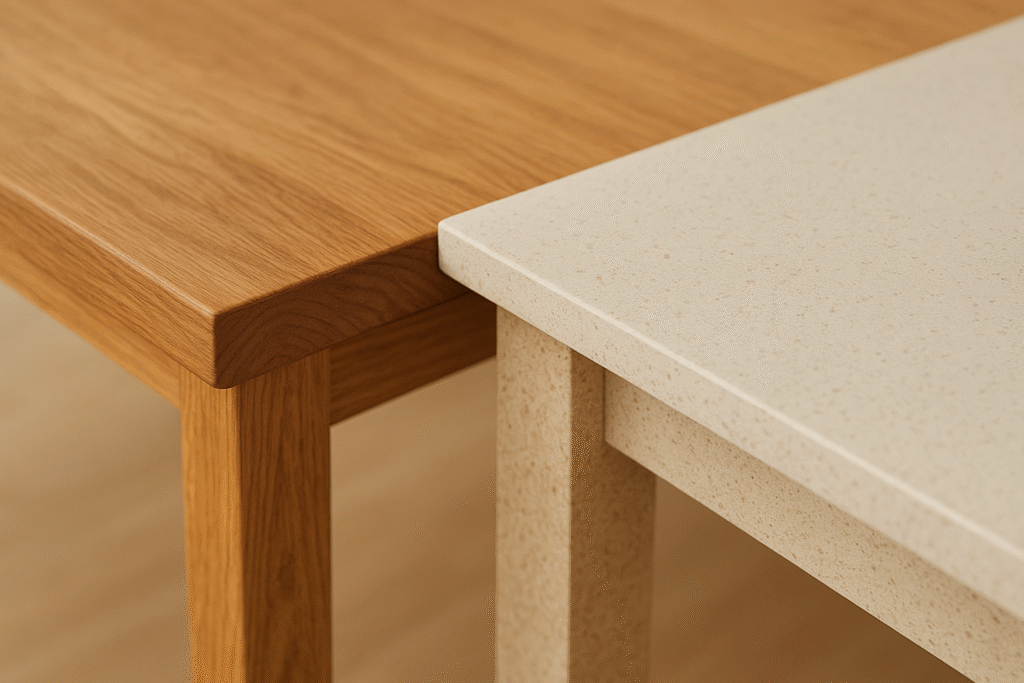
Quality furniture represents a significant financial commitment, often ranking among the largest purchases after your home and car. Unlike these other major purchases, furniture doesn’t come with financing options, making the upfront cost more noticeable.
The relationship between cost and quality varies dramatically across different furniture categories. Spending extra on a mattress or office chair makes sense because you use them daily and poor quality directly affects your health and comfort. Decorative accent pieces might not justify the same investment level since they’re primarily visual.
Construction quality becomes apparent over time. Solid wood furniture can last generations with proper care, while particle board pieces might need replacement within a few years. Real wood can be refinished and repaired, but manufactured materials typically end up in landfills when they show wear.
Your furniture choices also influence your home’s appeal to future buyers. While personal taste varies, well-chosen furniture can showcase your home’s potential and help buyers envision themselves living comfortably in the space. Furniture that’s obviously worn out or inappropriate for the room size can distract from your home’s positive features.
Style and Aesthetic Harmony: Creating Cohesive Living Spaces
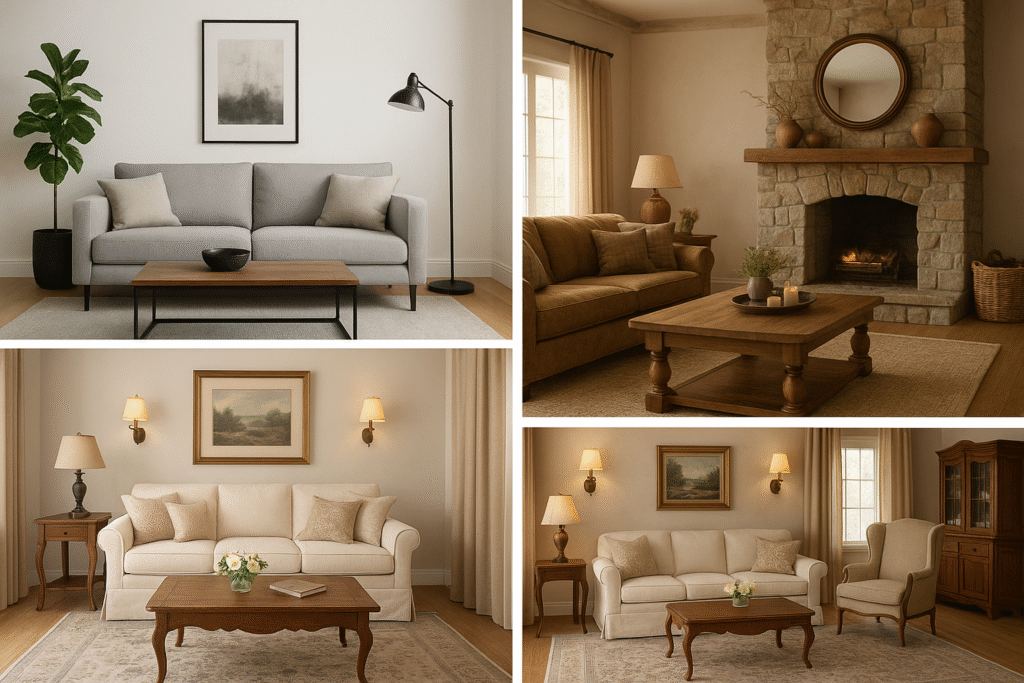
Matching Furniture Styles to Personal Preferences
Identifying your design preferences starts with paying attention to spaces where you feel most comfortable and relaxed. Maybe you love the clean lines and bright colors of modern hotels, or perhaps you’re drawn to the warm wood and soft textures of traditional homes. These reactions provide clues about what style elements might work in your own space.
Personal style isn’t just about following design magazines or trends. Your cultural background, family traditions, and life experiences all influence what feels like “home” to you. Someone who grew up in a farmhouse might gravitate toward rustic elements, while a city dweller might prefer sleek, space-efficient designs.
Balancing personal preferences with timeless design principles helps ensure your choices won’t feel dated quickly. Classic proportions and quality materials tend to age well, even when combined with more trendy accessories. You can always update small elements like pillows or artwork without replacing major furniture pieces.
Family input matters too, especially for shared spaces like living rooms and dining areas. Finding common ground might mean choosing neutral base pieces that everyone can live with, then adding personality through items that can be easily changed or moved to private spaces.
Color Coordination and Material Selection
Furniture colors interact with everything else in your room – wall colors, flooring, window treatments, and natural light. A dark wood dining table might look rich and elegant against light walls, but the same piece could disappear against dark walls or make a small room feel cramped.
Understanding your room’s lighting throughout the day helps guide color choices. North-facing rooms with cooler light might benefit from warmer furniture tones, while south-facing spaces can handle cooler colors without feeling cold. Artificial lighting also affects how furniture colors appear in the evening.
Mixing materials and textures adds visual interest without requiring bold colors. A smooth leather sofa paired with a rough wood coffee table and soft fabric pillows creates layers that feel sophisticated but not overwhelming. The key is varying textures while maintaining some common element like similar color temperatures or complementary shapes.
Creating focal points through furniture helps organize your room visually. This might mean choosing one statement piece like a colorful accent chair or an interesting dining table, then selecting other pieces to support rather than compete with that focal point. Too many competing elements can make a room feel chaotic.
Scale and Proportion in Room Planning
Selecting appropriately sized furniture makes the difference between a room that feels balanced and one that feels awkward. Oversized furniture can overwhelm a small space, but choosing pieces that are too small for a large room can make the space feel empty and uncomfortable.
Room dimensions provide the starting point for furniture sizing, but ceiling height also matters. High ceilings can handle taller furniture pieces like bookcases or canopy beds that might feel oppressive in rooms with standard ceiling heights. Similarly, furniture with low profiles can get lost in rooms with dramatic vertical space.
Proper spacing between furniture pieces ensures comfortable movement and conversation. Seating arranged for conversation should be close enough for easy talking without shouting, typically around 6 to 8 feet apart. Coffee tables should sit close enough to be useful but far enough from seating to avoid bumped knees.
Common sizing mistakes include pushing all furniture against walls in large rooms, which can make conversation difficult and create an impersonal feeling. In small rooms, the opposite problem occurs when oversized furniture blocks natural pathways or makes the space feel cramped.
Comfort and Functionality: Meeting Human Needs Through Design
Ergonomic Considerations for Daily Use
Comfort in furniture goes far beyond initial impressions in a showroom. Seating that supports proper posture becomes increasingly important as you spend more time in chairs for work, meals, or relaxation. Poor ergonomics can lead to back pain, neck strain, and general discomfort that affects your overall quality of life.
Different activities require different ergonomic considerations. Dining chairs need to position you at the right height for comfortable eating, typically with your elbows at roughly 90 degrees when your hands rest on the table. Office chairs require adjustable height and back support for extended sitting periods.
Height and depth requirements vary based on the intended users. Standard furniture dimensions work for average-height adults, but taller or shorter family members might need different considerations. Seat depth particularly affects comfort – too deep, and your back won’t reach the backrest; too shallow, and your legs won’t be properly supported.
Accessibility considerations become more important as family members age or face mobility challenges. Furniture with arms makes standing easier, while appropriate seat heights reduce strain on joints. Planning for these needs in advance is easier than retrofitting furniture choices later.
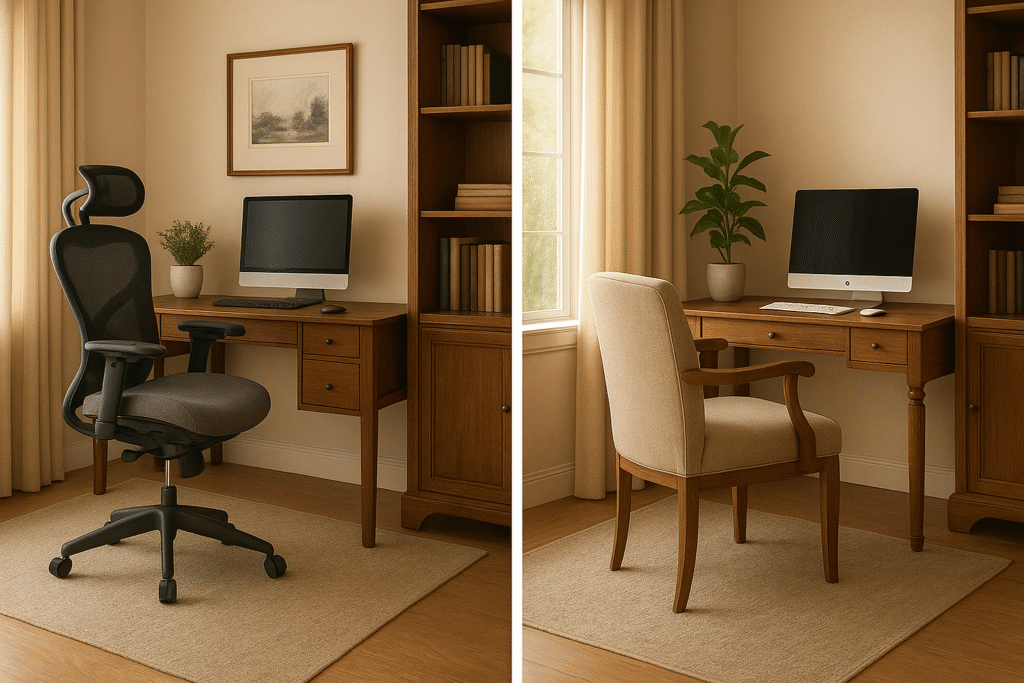
Multi-Purpose Furniture for Modern Living
Storage-integrated furniture helps maximize space efficiency while reducing clutter. Ottoman storage provides hidden space for blankets or games while serving as extra seating or a footrest. Dining tables with built-in drawers keep table linens and serving pieces convenient but out of sight.
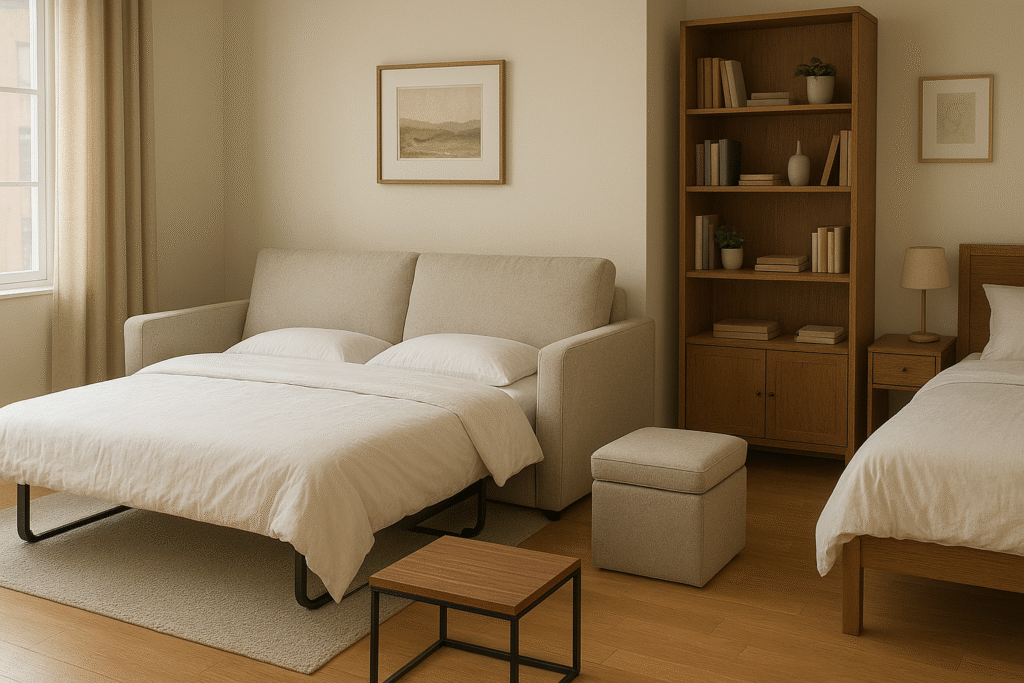
Expandable and convertible furniture offers flexibility for changing needs. Dining tables that extend for holiday gatherings or compress for daily use adapt to your lifestyle rather than forcing you to work around fixed limitations. Sofa beds serve double duty in guest rooms or studio apartments.
Space-saving designs particularly benefit smaller homes and apartments. Nesting tables provide surface space when needed but store compactly when not in use. Wall-mounted desks fold away to free floor space in multipurpose rooms.
The challenge with multi-purpose furniture lies in finding pieces that perform all functions well rather than compromising on everything. A storage ottoman that’s uncomfortable to sit on or a dining table that’s wobbly when extended defeats the purpose of the space-saving design.
Room-Specific Functional Requirements
Living room furniture needs to support various activities from casual TV watching to formal entertaining. Seating arrangements should accommodate both intimate family conversations and larger gatherings. Storage needs might include space for remote controls, magazines, games, and electronic equipment.
The focal point of most living rooms – whether a fireplace, entertainment center, or large window – influences furniture arrangement. Seating should relate to this focal point while still allowing for conversation among family members and guests.
Bedroom furniture primarily supports rest and personal storage needs. The bed obviously takes priority, but bedside tables, dresser space, and seating for putting on shoes all contribute to the room’s functionality. Adequate lighting for reading and getting dressed requires coordination between furniture placement and light sources.
Kitchen and dining furniture must withstand heavy daily use while supporting meal preparation and family gatherings. Dining chairs need to be comfortable for extended sitting but also easy to clean after meals. Kitchen seating should position people at appropriate heights for counter or island surfaces.
Space Optimization: Making the Most of Your Available Area
Furniture Arrangement Strategies for Different Room Sizes
Small apartments and condos require strategic thinking about every piece of furniture. Multi-functional pieces become essential, and every item should earn its place by serving multiple purposes or being used frequently. Furniture that can be easily moved or stored allows for flexible use of limited space.
In small spaces, furniture placement along walls might seem logical, but floating pieces in the room can actually create better traffic flow and more usable space. A sofa positioned to divide a studio apartment creates separate living and sleeping areas without requiring permanent walls.
Large rooms present the opposite challenge – filling space without creating uncomfortable, empty areas. Grouping furniture into multiple conversation areas works better than spreading pieces evenly throughout the room. This creates intimate spaces within the larger room while avoiding the echo-chamber effect of too much empty space.
Open floor plans require furniture to help define different functional areas. A console table behind a sofa can separate living and dining spaces without blocking sight lines. Area rugs help define seating groups and create visual boundaries between different activity zones.
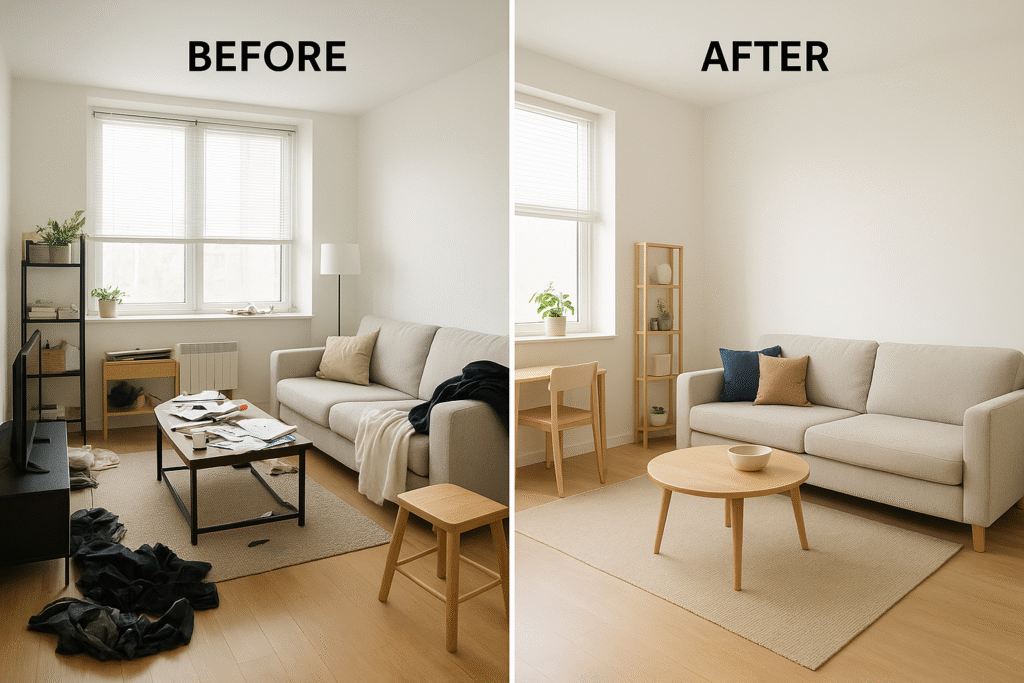
Traffic Flow and Movement Patterns
Natural movement patterns through your home should influence furniture placement more than achieving perfect symmetry or following design rules. People tend to take the most direct path between frequently used areas, and furniture should support rather than obstruct these patterns.
Main walkways through rooms should remain clear and wide enough for comfortable passage. This becomes particularly important in homes with mobility aids or when moving furniture for cleaning. A clear path also makes rooms feel more spacious and welcoming.
Furniture placement that blocks doorways or windows creates both practical problems and psychological discomfort. Even when these areas aren’t used frequently, blocked access makes spaces feel cramped and poorly planned.
Consider how furniture arrangement affects daily routines. Can you easily access closets and storage? Does the coffee table placement make TV watching comfortable? Can multiple people move through the kitchen simultaneously during meal preparation?
Visual Space Enhancement Techniques
Furniture choices can dramatically affect how spacious a room feels, regardless of actual square footage. Light-colored furniture reflects more light and creates an airier feeling than dark pieces, which tend to absorb light and feel heavier visually.
Glass and acrylic furniture pieces take up physical space but maintain visual openness. A glass coffee table provides surface area without blocking sight lines, while an acrylic chair offers seating without visual weight. These materials work particularly well in small spaces or rooms with limited natural light.
Furniture with legs raises pieces off the floor, creating a sense of openness and making rooms easier to clean. This visual trick makes even substantial pieces like sofas feel less heavy than furniture that sits directly on the floor.
Strategic use of mirrors and reflective surfaces can expand the apparent size of rooms, but these elements need to coordinate with furniture placement to be effective. Mirrors positioned to reflect interesting furniture groupings or natural light sources work better than those that show cluttered or unappealing views.
Quality and Durability: Making Smart Long-Term Investments
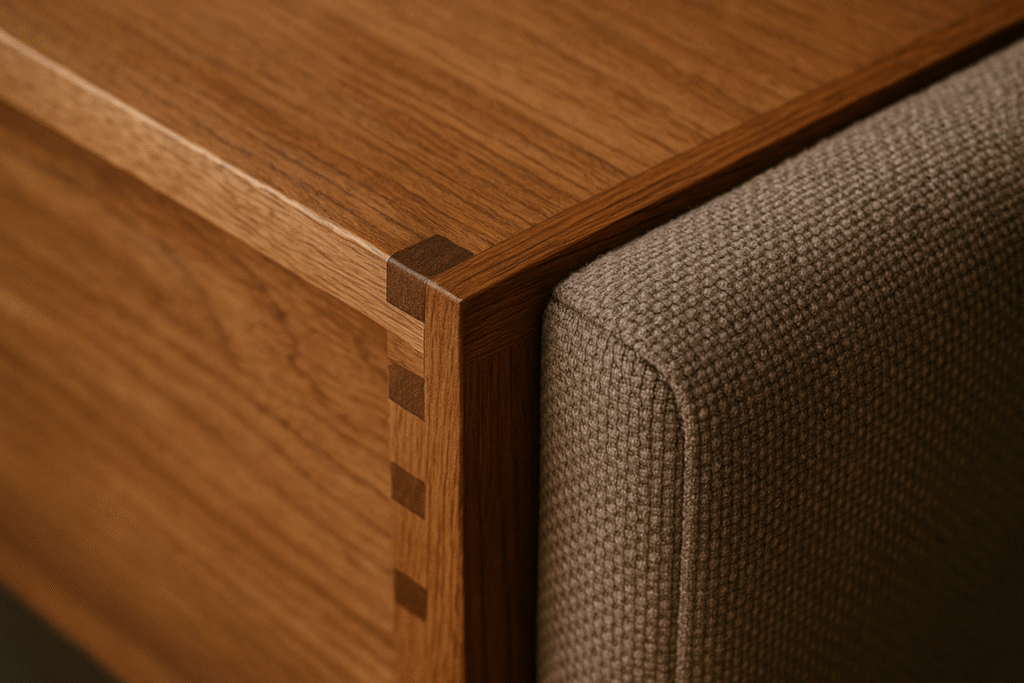
Construction Methods and Materials Assessment
Understanding furniture construction helps you evaluate whether a piece justifies its price and will meet your long-term needs. Solid wood construction costs more initially but can last generations with proper care. Veneer over solid wood cores offers a good compromise between cost and quality, while particle board or MDF should be reserved for pieces that won’t see heavy use.
Joint construction reveals a lot about furniture quality. Dovetail joints in drawers indicate superior craftsmanship and durability compared to simple butt joints or stapled construction. Mortise and tenon joints in chairs and tables provide strength that will last through years of daily use.
Upholstery quality affects both durability and comfort over time. Natural fabrics like wool and cotton tend to age better than synthetic materials, while leather develops character with use rather than simply showing wear. The frame construction under upholstery matters too – hardwood frames with proper spring systems maintain their shape and comfort longer than frames made from softwood or metal.
Hardware quality becomes apparent quickly with daily use. Drawer slides, cabinet hinges, and furniture casters should operate smoothly and feel substantial. Cheap hardware often fails within the first few years, sometimes making entire pieces unusable even when the main structure remains sound.
Maintenance Requirements and Care Considerations
Different furniture materials require varying levels of ongoing care and maintenance. Wood furniture needs periodic cleaning and occasional refinishing, but these investments can extend the life significantly. Understanding these requirements before purchase helps you choose pieces that match your willingness to perform maintenance.
Daily cleaning requirements vary dramatically between materials. Leather needs regular conditioning to prevent cracking, while microfiber fabrics might require professional cleaning to maintain their appearance. Glass surfaces show every fingerprint but clean easily, while wood finishes might water-spot if not promptly dried.
Professional restoration can extend furniture life significantly, but this option only makes sense for pieces with good underlying construction. A well-made dining table can be refinished multiple times over decades of use, while particle board furniture generally can’t be restored economically.
Protecting furniture from damage costs less than replacement or repair. Using coasters, placemats, and furniture pads prevents most water rings and scratches. Positioning furniture away from direct sunlight prevents fading, while controlling humidity helps prevent wood cracking and joint loosening.
Warranty Options and Manufacturer Reputation
Furniture warranties vary significantly in coverage and duration. Structural warranties might cover frame defects for decades, while fabric and finish warranties typically last only a few years. Understanding what’s covered and for how long helps you evaluate the true value of your purchase.
Manufacturer reputation affects both initial quality and long-term support. Established companies with good customer service records are more likely to honor warranties and provide replacement parts when needed. Local manufacturers might offer better service than imported furniture companies with limited US support.
The difference between local and imported furniture often comes down to service and support rather than just quality. Local manufacturers can often provide custom sizing, repair services, and replacement parts that aren’t available for imported pieces. However, imported furniture might offer style options and price points not available locally.
Researching customer reviews and complaint records helps identify manufacturers with consistent quality and service. Look for patterns in complaints – occasional shipping damage happens to everyone, but consistent reports of poor construction or customer service indicate deeper problems.
Summary
Furniture selection forms the backbone of successful residential interior design, influencing everything from daily comfort to long-term satisfaction with your living space. The right furniture choices create functional, beautiful environments that support your lifestyle while reflecting your personal taste and values.
By considering factors such as style harmony, comfort requirements, space optimization, and quality construction, homeowners can make informed decisions that enhance their daily living experience and protect their investment. Thoughtful furniture selection requires balancing immediate needs with long-term goals, ensuring that your home remains both practical and appealing for years to come.
The furniture you choose today will shape countless moments in your future – family gatherings, quiet evenings, productive work sessions, and peaceful nights of rest. Taking time to make thoughtful decisions now pays dividends in comfort, satisfaction, and financial value for years ahead.

Frequently Asked Questions
Q: How much should I budget for furnishing a new home?
A: Generally, plan to spend 20-25% of your home’s value on furnishing, though this can vary based on your priorities and existing possessions. Focus your budget on high-use items like mattresses and seating first.
Q: Should I buy all my furniture at once or gradually over time?
A: Gradual purchasing often works better, allowing you to live in the space and understand your actual needs. Start with essential pieces and add others as you determine what works best for your lifestyle.
Q: How do I choose furniture that will stay stylish over time?
A: Select classic designs in neutral colors for major pieces like sofas and dining tables. Add personality and current trends through easily replaceable items like pillows, artwork, and accent pieces.
Q: What’s the best way to test furniture comfort before purchasing?
A: Spend at least 15 minutes sitting on chairs and sofas in the showroom. Test different positions you’d naturally use at home, and don’t hesitate to visit multiple times before making final decisions.
Q: How important is it to match all furniture pieces exactly?
A: Exact matching isn’t necessary and can look monotonous. Instead, aim for pieces that share common elements like similar wood tones, complementary colors, or consistent style periods while allowing for some variety.

